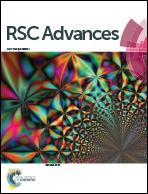Syntheses, crystal structures and photoluminescence properties of Ca9Y(PO4)5(SiO4)F1.5O0.25:Ln3+ (Ln3+ = Eu3+/Tb3+/Dy3+/Sm3+) phosphors for near-UV white LEDs
Abstract
A series of single-doped Ca9Y(PO4)5(SiO4)F1.5O0.25:Ln3+ (Ln3+ = Eu3+/Tb3+/Dy3+/Sm3+) phosphors have been prepared via conventional high-temperature solid–state reaction. The structural refinement, photoluminescence properties, and decay curves were studied in detail. Under near-UV excitation, the Ca9Y(PO4)5(SiO4)F1.5O0.25:Eu3+/Tb3+/Dy3+/Sm3+ phosphors show the characteristic emissions of Eu3+ (5D0–7F2, red), Tb3+ (5D4–7F5, green), Sm3+ (4G5/2–6H7/2, red), and Dy3+ (4F9/2–6H13/2, yellow). The emission intensities of Ca9Y(1−x/z)(PO4)5(SiO4)F1.5O0.25:xEu3+/zSm3+ are maximized when x = 0.16 and z = 0.10, and the concentration quenching mechanisms are both dominated by dipole–dipole interactions. The excitation spectra of the Ca9Y(PO4)5(SiO4)F1.5O0.25:Eu3+/Sm3+ phosphors show the strongest absorption at about 400 nm, which matches well with the commercially available near-UV-emitting InGaN-based light emitting-diode (LED) chip. Finally, a red LED was fabricated using the present phosphors (with the composition of Ca9Y(PO4)5(SiO4)F1.5O0.25:Eu3+/Sm3+) and exhibited a red emission with high color purity. All the results indicate that Ca9Y(PO4)5(SiO4)F1.5O0.25:Ln3+ phosphors are promising phosphors for white LEDs.


 Please wait while we load your content...
Please wait while we load your content...